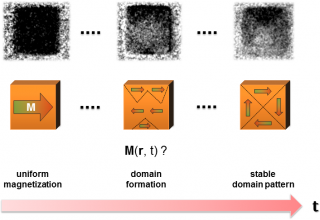Modern computer technology stores data at ever increasing speed and density by writing magnetization patterns into suitable materials. For the first time a group of scientists could observe the magnetic dynamics inside a structure.
How do magnetic domains develop in very small structures? A team of scientists from Prof. Markus Drescher’s and Dr. habil. Guido Meier’s project groups tried to find answers to this question. In the journal Physical Review B the scientists report their work, which could help developing digital data storage. “Our experiment could for the first time image in real-time how magnetic domains develop in very small structures,” explains Dr. Philipp Wessels, CUI-scientist and the study’s leading author. The study became possible due to a strong collaboration between Universität Hamburg and DESY.

Three snapshots showing the development of a stable magnetic domain pattern plus illustrations explaining the process.
The magnetization in a ferromagnetic material is generally not uniform but rather divided into microscopically small units called domains. Wessels: “However, no one has ever directly captured how an equilibrium domain pattern is formed in real-time.” To perform the experiment, the scientists first destroyed the stable domain pattern and drove the magnetization into an unstable uniform alignment. With the help of a custom-built X-ray microscope within DESY’s synchrotron radiation source PETRA III, which was developed in association with a group headed by Prof. Thomas Wilhein at the Koblenz University of Applied Science, they were then able to observe the dynamic reorganization of the pattern. Using the short wavelenghts and the relatively short pulses created by PETRA III they took snapshots of the magnetization process with high spatial resolution down to a few ten nanometers and at time resolution of a few hundred picoseconds. Thus a video of the domain destruction and relaxation dynamics could be recorded in slow motion.
Visualizing these processes is important for developing future magnetic storage devices based on small domains.
Also view: Scientists film magnetic memory in super slo-mo
Original:
Wessels P., Ewald J., Wieland M., Nisius T., Vogel A., Viefhaus J., Meier G., Wilhein T., and Drescher M.
“Time-resolved imaging of domain pattern destruction and recovery via nonequilibrium magnetization states”
Phys. Rev. B 90, 184417 (2014)
DOI: 10.1103/PhysRevB.90.184417

